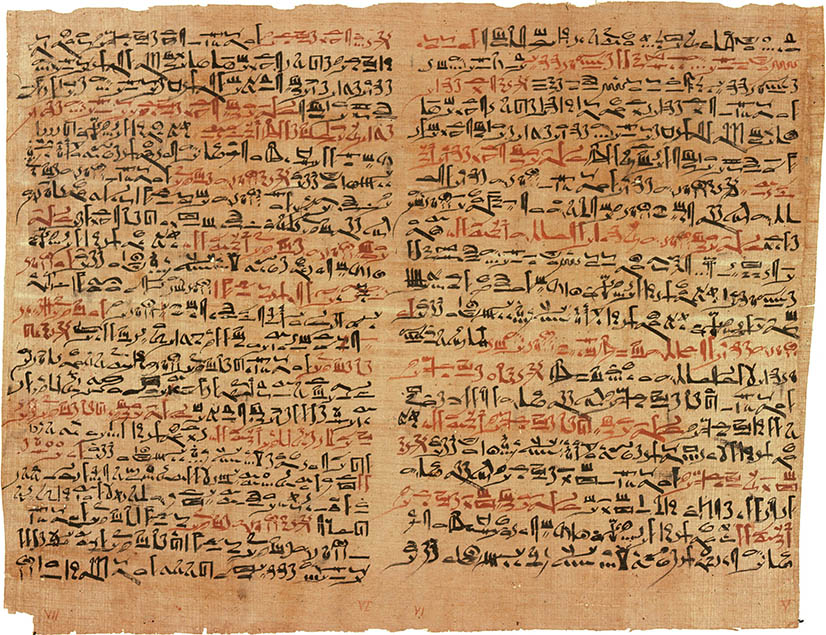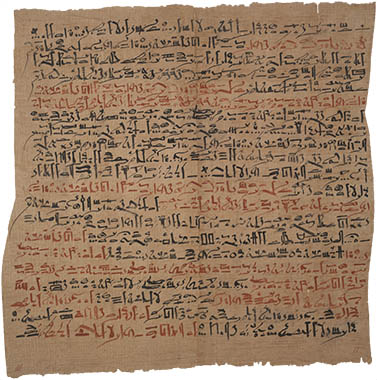3
The Edwin Smith Papyrus
Hieratic
This papyrus fragment, written in typical Middle Kingdom Egyptian hieratic bookhand, ca. 1600 BC, includes 17 columns (377 lines) on the recto and five columns (92 lines) on the verso and appears to be the work of a single scribe. The papyrus is likely a composite of a much older text (perhaps 3000 BC) and later glosses on 48 trauma cases. It details the examination, diagnosis and treatment of injuries listed in anatomical order, starting with cranial, then facial, cervical, thoracic, upper limb, and spinal injuries, and is remarkably sophisticated and rational, invoking magic as a treatment only once. It is widely considered the first treatise on neurosurgery and includes the earliest references to cranial sutures, the meninges, the external surface of the brain, the cerebrospinal fluid, and intracranial pulsations.
Edwin Smith, an American living in Cairo in the latter half of the 19th century, was a farmer, adventurer and collector, but also a money-lender and perhaps forger of antiquities. In 1862 he bought two papyri from the Luxor antiquities dealer Mustafa Agha (who was apparently of similar character). The first he sold to the German Egyptologist, Georg Ebers,1 and the other, the one named after him, he kept to his death. Smith even personally attempted a translation, but it was not until 1930, after his daughter donated it to the New York Academy of Medicine, that James Breasted, the noted early American Egyptologist, fully translated it and found it to be “the oldest nucleus of really scientific knowledge in the world.”2
Recto, column 3. NLM
Recto, column 4
Formal hieroglyphic was the provence of artisans; perfectly suitable for labor-intensive projects like royal tombs or the accouterments of a boy king, but less so for, say, an administrative decree, or a pay voucher, or a shopping list. So the scribes developed hieratic; a cursive, shorthand version particularly suitable for writing on papyrus. Hieratic existed in two forms, a highly cursive and often abbreviated “businesshand” for administrative texts, and an uncial “bookhand” for formal texts, such as the one shown above.

Hieroglyphic (top), hieratic, and demotic (bottom)
Hieratic did not evolve out of formal hieroglyphic, but was developed rather early on as an alternative to the formal script and for the next three millennia they existed in parallel; as the formal script grew hieratic became even more cursive and abbreviated, resorting to a very large number of ligatures.3 By 600 BC hieratic had evolved into demotic, which shows almost no trace of its hieroglyphic roots. Demotic was eventually mixed with Greek, becoming Coptic.

Coptic
The hieroglyphs, especially hieratic, were the ancestor of nearly every non Chinese-based script in use today, including the Latin alphabet you are reading now. The family tree goes something like this: hieratic → proto-Sinaitic → Canaanite → Phoenician → Greek → Etruscan → Latin.
1. The other papyrus, named after its buyer, the German Egyptologist Georg Ebers, turned out to be a medical text written in hieratic around the same time as the Smith papyrus. Among its several hundred magical incantations and formulae was a contraceptive pessary; “To make a women cease to become pregnant for 1 year, 2 years or 3 years: k” of acacia, d’rt, dates, are ground with a fine him of honey, seed-wool is moistened herewith and placed in her vulva.” It turns out that acacia, or at least the lactic acid present in acacia, does have contraceptive activity. An earlier text, the Kahun papyrus, ca.1825 BC, suggests a pessary of crocodile’s dung cut up on auyt-paste (honey), sprinkled (with sour milk). Note that modern usage of the term pessary denotes a latex or silicone ring designed to support pelvic organ prolapse or procidentia, which is something else altogether..
2. Breasted, James Henry. The Edwin Smith Surgical Papyrus. Chicago: University of Chicago Press, 1930. There are many online translations and discussions. Here’s one: Wilkins, Robert H. Neurosurgical Classic XVII - Edwin Smith Surgical Papyrus. J Neurosurg 1964 Mar;21(3): 240-244.
3. So many ligatures, in fact, that there has never been any real attempt to model a hieratic typeface. Egyptologists simply substitute the appropriate formal glyph.
18 Dec 2008, updated 28 Dec 2011 ‧ Typographia Historia


